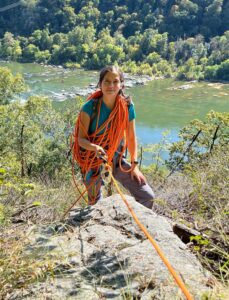Hope Kenmore – Stony Brook University
Evaluating restoration success and revegetation of sediment addition projects in Northeast US salt marshes
Hope is a first-year PhD student in the Ecology and Evolution Department at Stony Brook University, advised by Dr. Beth Watson. Her research interests focus on the ecology and conservation of coastal wetlands, particularly those under anthropogenic pressures including urbanization, climate change, and sea-level rise. For her summer 2025 project, funded by the Laderman Student Grant, she will use a combination of field sampling and remote sensing methods to assess the success of thin-layer sediment restoration efforts in salt marshes across the Northeast. By comparing plant productivity and stress indicators at both restored and natural marshes, she aims to increase our understanding of the marsh revegetation process and improve future marsh restoration design. Prior to starting graduate school, Hope worked as a researcher with Aanika Biosciences, an agricultural biotech startup, and as a lab technician at Weill Cornell Medicine. She received my BA in biology and dance from Marymount Manhattan College in 2020, and a Postgraduate Certificate in Ecological Survey Techniques from the University of Oxford in 2023.
Diana Albuja – Pennsylvania State University
Japanese Barberry Control and Active Restoration Strategies for Climate Resilient Forests
 Diana is a Ph.D. student in the Ecology program and the Transdisciplinary Research on Environment and Society dual-title (TREES) at Pennsylvania State University. She has always been in plant and restoration ecology, and she completed her undergraduate studies in Ecology and Environmental Conservation from the National University of Santiago del Estero, Argentina. As an undergraduate and a professional, Diana worked on different ecosystems such as the Amazon Rainforest, Andrean Mountains, and the Galapagos Islands. Those research projects were focused on vegetaiont community assemblages and insect ecology. However, she decided to focus her efforts on forest restoration. Diana’s research centers on testing practical, science-based techniques for forest owners and land managers to control the invasive shrub Japanese Barberry (Berberis thunbergii DC) in the understory of eastern successional deciduous forests. The goal is to support the recovery and long-term establishment of native plant communities while also promoting climate-resilient forests in the face of increasing environmental stressors.
Diana is a Ph.D. student in the Ecology program and the Transdisciplinary Research on Environment and Society dual-title (TREES) at Pennsylvania State University. She has always been in plant and restoration ecology, and she completed her undergraduate studies in Ecology and Environmental Conservation from the National University of Santiago del Estero, Argentina. As an undergraduate and a professional, Diana worked on different ecosystems such as the Amazon Rainforest, Andrean Mountains, and the Galapagos Islands. Those research projects were focused on vegetaiont community assemblages and insect ecology. However, she decided to focus her efforts on forest restoration. Diana’s research centers on testing practical, science-based techniques for forest owners and land managers to control the invasive shrub Japanese Barberry (Berberis thunbergii DC) in the understory of eastern successional deciduous forests. The goal is to support the recovery and long-term establishment of native plant communities while also promoting climate-resilient forests in the face of increasing environmental stressors.
